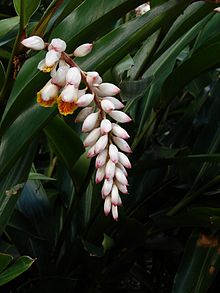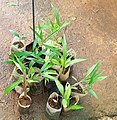Alpinia
| Alpinia | |
|---|---|

| |
| Alpinia zerumbet | |
| Scientific classification | |
| Kingdom: | Plantae |
| Clade: | Tracheophytes |
| Clade: | Angiosperms |
| Clade: | Monocots |
| Clade: | Commelinids |
| Order: | Zingiberales |
| Family: | Zingiberaceae |
| Subfamily: | Alpinioideae |
| Tribe: | Alpinieae |
| Genus: | Alpinia Roxb., 1810 |
| Species | |
|
See text | |
Alpinia is a genus of flowering plants in the ginger family, Zingiberaceae. It is named for Prospero Alpini, a 17th-century Italian botanist who specialized in exotic plants.[1] Species are native to Asia, Australia, and the Pacific Islands, where they occur in tropical and subtropical climates.[2] Several species are cultivated as ornamental plants.[3] Species of the genus are known generally as shell ginger.[3][4]
Description[]
These herbs lack true stems, but have pseudostems usually up to about 3 metres (9.8 ft) long which are composed of the overlapping leaf sheaths.[2][3] A few species have been known to reach 8 metres (26 ft).[5] They grow from thick rhizomes. The leaves are lance-shaped to oblong. The inflorescence takes the form of a spike, a panicle, or a raceme. It may be hooded in bracts and bracteoles. The flower has a shallowly toothed calyx which is sometimes split on one side. The flower corolla is a cylindrical tube with three lobes at the mouth, the middle lobe larger and hoodlike in some taxa. There is one fertile stamen and two staminodes, which are often joined into a petal-like labellum, a structure that is inconspicuous in some species and quite showy in others. The fruit is a rounded, dry or fleshy capsule.[2][3] The plants are generally aromatic due to their essential oils.[6]


Ecology[]
Most Alpinia are plants of forest understory habitat. Most are pollinated by large bees, but some are pollinated by birds and bats.[5]
Species[]
This is the largest genus in the ginger family,[5] with about 230 species.[2][3][5] A number of those are commonly grown for their flowers, and others are used as spices. Species include:[7]
- Alpinia acuminata
- Alpinia aquatica
- Alpinia beamanii
- (Gagnep.)
- Alpinia caerulea – Australian native ginger
- – heen araththa, cardamom ginger
- Alpinia conchigera – lesser alpinia
- Alpinia galanga – greater galangal
- Alpinia globosa – round Chinese cardamom
- Alpinia javanica – Javanese alpinia
- Alpinia katsumadae
- Alpinia malaccensis – rathkihiriya
- Alpinia melanocarpa – black-fruited alpinia
- – small shell ginger, orchid ginger, narrow-leaved alpinia
- Alpinia nigra
- Alpinia nutans – dwarf cardamom, ginger lily, shell ginger
- Alpinia officinarum – lesser galangal, Chinese ginger
- Alpinia oxyphylla – sharp-leaf galangal
- Alpinia petiolata – stalked-leaved alpinia
- Alpinia purpurata – red ginger
- – Java galangal
- Alpinia rafflesiana – Raffles' alpinia
- Alpinia tonrokuensis
- – variegate-ginger
- Alpinia zerumbet – shell ginger (synonym Alpinia speciosa)
Gallery[]



Alpinia speciosa

Alpinia hainanensis ' Shengzhen' from Flower View[8]
See also[]
References[]
| Wikimedia Commons has media related to Alpinia. |
- ^ Simonetti, G. (1990). Stanley Schuler (ed.). Simon & Schuster's Guide to Herbs and Spices. Simon & Schuster, Inc. ISBN 0-671-73489-X.
- ^ a b c d Alpinia. Flora of China.
- ^ a b c d e Alpinia. Flora of North America.
- ^ Alpinia. Integrated Taxonomic Information System (ITIS).
- ^ a b c d Kress, W. J., et al. (2005). "The molecular phylogeny of Alpinia (Zingiberaceae): a complex and polyphyletic genus of gingers". American Journal of Botany 92(1), 167-78.
- ^ Victório, C. P. (2011). "Therapeutic value of the genus Alpinia, Zingiberaceae". Revista Brasileira de Farmacognosia 21(1), 194-201.
- ^ Alpinia. The Plant List.
- ^ Alpinia hainanensis ' Shengzhen'. "Alpinia hainanensis ' Shengzhen'". Flower View. Archived from the original on 2016-03-04. Retrieved 2015-09-12.
- Alpinia
- Zingiberaceae genera






